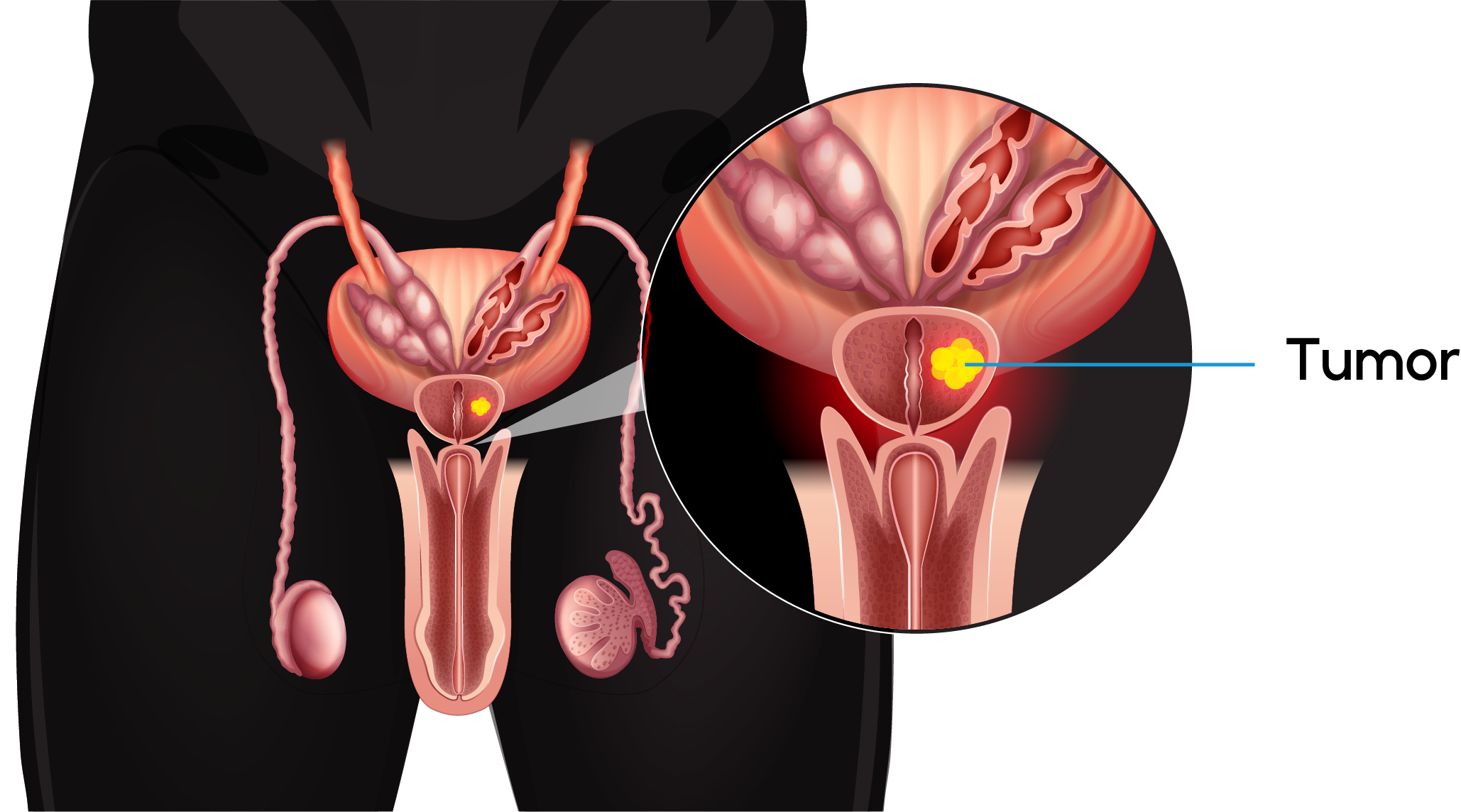About Prostate Cancer

Syncromune’s first therapy candidate, SYNC-T SV-102 is being developed to optimize the treatment of advanced metastatic castration-resistant prostate cancer, for which currently there is no cure
The Prostate Gland

The prostate is a small gland approximately the size and shape of a walnut that sits just below the bladder, in front of the rectum, and surrounds the upper part of the urethra (the tube that carries urine from the bladder).
The prostate’s primary function is to supply part of the seminal fluid (semen) which mixes with sperm from the testes and is necessary for reproduction. Within the semen produced by the prostate is a protein called prostate-specific antigen (PSA), and levels may increase if a man has benign prostatic hyperplasia (BPH – non-cancerous prostate enlargement) or prostate cancer. PSA levels can also increase due to age, recent sexual or physical activity, or an enlarged or inflamed prostate gland.
PSA testing is one of the most prominent methods of screening for prostate cancer and can help to detect the disease at an early stage. Based on several individual health factors, PSA levels can vary amongst men, and physicians often analyze trends of any rate of PSA rise over time.

Prostate location and anatomy
Prostate Cancer Overview

Prostate cancer occurs when cells grow and divide more rapidly than normal cells do. The accumulating abnormal cells can grow and create a tumor, referred to as malignant (cancerous). Prostate cancer is one of the most common types of cancer, with 1-in-8 men diagnosed with the disease during their lifetime. The most common risk factors are older age, race (black people have a greater risk than other races), family history, and obesity. Prostate cancer can grow slowly and remain confined to the prostate gland, where it may not cause serious harm.
However, while some types of prostate cancer grow slowly and may need minimal or even no treatment, other types are aggressive and can spread quickly. The cancer can spread from the prostate to surrounding organs, lymph nodes, and bone. When this happens, the disease is referred to as metastatic prostate cancer. Prostate cancer that is more advanced may cause signs and symptoms such as:
- Trouble urinating or decreased force in the stream of urine
- Blood in the urine
- Bone pain
- Unexpected weight loss
- Erectile dysfunction

Prostate with depiction of a tumor
Diagnosis & Staging

Screening
Screening is testing to find cancer before there are symptoms and early detection for prostate cancer is highly important, as beginning stage prostate cancer is curable. There are varying opinions about what age and circumstances that men should undergo screening. The American Cancer Society recommends that men have a chance to make an informed decision about whether to be screened for prostate cancer and should consider talking to a health care provider at1:
- Age 50 for men who are at average risk of prostate cancer and are expected to live at least 10 more years
- Age 45 for men at high risk of developing prostate cancer. This includes African American men and men who have a first-degree relative (father or brother) diagnosed with prostate cancer at an early age (younger than age 65).
- Age 40 for men at even higher risk (those with more than one first-degree relative who had prostate cancer at an early age)
Diagnosis
The initial primary methods for early screening and detection include a prostate-specific antigen (PSA) blood test and a digital rectal exam.
Digital Rectal Exam
A digital rectal exam (DRE) is used by physicians to physically palpate the prostate to detect any any enlargement or hard areas that could be cancer.
PSA Blood Test
A PSA blood test can be used to screen for prostate cancer in men without symptoms and is one of the first tests conducted in men who have symptoms that may be related to prostate cancer. PSA in the blood is measured in units called nanograms per milliliter (ng/mL). There is no set PSA level that can definitely determine if a man does or doesn’t have prostate cancer. Generally, most doctors use a level somewhere between 2.5 – 4.0 ng/mL to decide if further testing should be performed.
If the results of these initial screening tests indicate that prostate cancer is a possibility, a prostate biopsy may be performed to confirm a diagnosis.
Prostate Biopsy
A biopsy involves using a needle that is inserted into the prostate typically using transrectal ultrasound to guide the needle. Several samples may be taken depending on the individual patient. If prostate cancer is detected, the cancer will be assigned a grade known as a Gleason score which indicates the severity of the cancer. A low grade looks more like normal prostate tissue whereas a high grade looks very abnormal.

Prostate biopsy using transrectal ultrasound
Stages of Prostate Cancer
In addition, a staging system is used to describe how far the cancer has spread. The main stages range from 1 through 4, with some stages further split into substages.

Normal Prostate
No cancer present

Stage 1
Cancer that is contained within the prostate with a PSA < 10 ng/mL

Stage 2
Cancer contained within the prostate with PSA between 10 and 20 ng/mL

Stage 3
Ranging from cancer contained within the prostate with a PSA > 20 ng/mL to cancer that might or might not be spreading outside of the prostate gland

Stage 4
Ranging from cancer that has spread to only nearby lymph nodes to more aggressive spreading to other tissues, bones, or organs
References:
1. American Cancer Society. (2023, November 22). American Cancer Society Recommendations for Prostate Cancer Early Detection. https://www.fda.gov/patients/clinical-trials-what-patients-need-know [Accessed 25 August 2024]
2. U.S. Food and Drug Administration. (2018, January 4). The Drug Development Process. https://www.fda.gov/patients/learn-about-drug-and-device-approvals/drug-development-process [Accessed 20 August 2024]
3. American Cancer Society. (2023, November 22). Prostate Cancer Stages. https://www.cancer.org/cancer/types/prostate-cancer/detection-diagnosis-staging/staging.html [Accessed 26 August 2024]
Statistics

U.S. Prostate Cancer Statistics
313,780 new cases of prostate cancer are expected to be diagnosed in 2025
In the U.S. a man dies from prostate cancer every 15 minutes

1-in-8 men will be diagnosed with prostate cancer during his lifetime
The 5-year survival rate for prostate cancer diagnosed in its earliest stages is over 99%; however, the 5-year survival rate for advanced disease drops to 37%
African American men have a 70% higher incidence of prostate cancer than white men
Currently there are more than 3.3 million prostate cancer survivors
Source: American Cancer Society. Cancer Facts & Figures 2025. https://www.cancer.org/content/dam/cancer-org/research/cancer-facts-and-statistics/annual-cancer-facts-and-figures/2025/2025-cancer-facts-and-figures-acs.pdf [Accessed 13 March 2025]
Additional Resources

There are numerous prostate cancer advocacy groups and other cancer resources that provide extensive information about the disease, cancer in general, current treatment options based on cancer stage, and support groups designed to help patients and caregivers. For your reference, below is a list of of some organizations along with links to their websites
For Prostate Cancer
- Learning Center

About Clinical Trials

LEGION-100 Trial

SYNC-T® Therapy

For Patients & Caregivers

For Healthcare Professionals

Syncromune Trials

Educational Resources

For Patients & Caregivers




